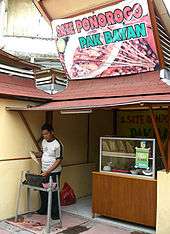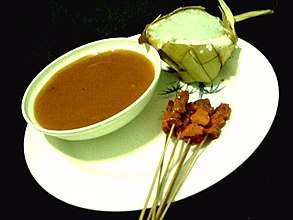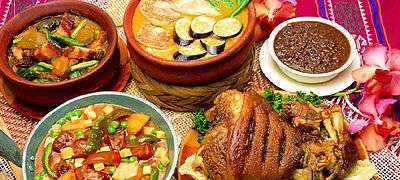Satay
Satay (/ˈsæteɪ/ SA-tay, /ˈsɑːteɪ/ SAH-tay), or sate in Indonesian and Malay spelling, is a Southeast Asian dish of seasoned, skewered and grilled meat, served with a sauce. It is from Indonesia and popular in Malaysia, Philippines, Singapore, Thailand, and Brunei.[4][5] It also recognized and popular in Suriname and the Netherlands.[6] Satay may consist of diced or sliced chicken, goat, mutton, beef, pork, fish, other meats, or tofu; the more authentic version uses skewers from the midrib of the coconut palm frond, although bamboo skewers are often used. These are grilled or barbecued over a wood or charcoal fire, then served with various spicy seasonings. Satay can be served in various sauces, however most often they are served in a combination of soy and peanut sauce.[7] Hence, peanut sauce is often called satay sauce.[8]
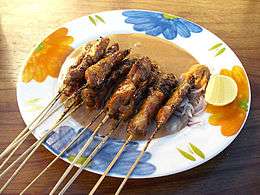 | |
| Alternative names | Sate, Satai, Satti |
|---|---|
| Course | Entrée or main course |
| Place of origin | Indonesia[1][2][3] |
| Region or state | Southeast Asia, Suriname, Sri Lanka, and Netherlands |
| Associated national cuisine | Indonesia[1] |
| Serving temperature | Hot |
| Main ingredients | Skewered and grilled meats with various sauces, mainly peanut sauce |
| Variations | Numerous variations across Southeast Asia |
 |
| This article is part of the series on |
| Indonesian cuisine Masakan Indonesia |
|---|
|
Ingredients |
|
Styles |
|
Holidays and festivals |
|
Related cuisines |
|
|
Satay is believed to have originated in Java,[2][9][10][11][3] but has spread to almost anywhere in Indonesia, where it has become a national dish.[12][1][13][14] It is also popular in many other Southeast Asian countries including Philippines, Thailand, Malaysia, Singapore and Vietnam.[15] A key feature of Thai satay is the inclusion of pork as a meat option, and Thai-style peanut sauce. Meanwhile, Indonesian satay is often served with kecap manis – a sweet soy sauce, and is often accompanied with lontong, a type of rice cake. In Sri Lanka, it has become a staple of the local diet as a result of the influences from the local Malay community.[16]
In Indonesia, the diversity of the country (see Indonesian cuisine) has produced a wide variety of satays. It is popular as street food,[2] and it can be obtained from a travelling satay vendor, from a street-side tent-restaurant, in an upper-class restaurant, or at traditional celebration feasts.
Close analogues are yakitori from Japan, kǎoròu chuàn from China, shish kebab from Turkey and the Middle East, shashlik from the Caucasus, and sosatie from South Africa. It is listed at number 14 on World's 50 most delicious foods readers' poll compiled by CNN Go in 2011.[17]
Origin and history
Jennifer Brennan (1988), Encyclopaedia of Chinese and Oriental Cookery[18]
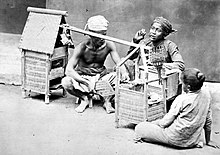
According to the Oxford English Dictionary, the English word "satay" is derived from the Malay word satai,[19] also saté or sate in Indonesian, ultimately originating from Tamil catai, a regional variant of tacai meaning "flesh".[19][20] The usage in English was first attested in 1917 with reference to a "satai" seller in Singapore, later a mention of saté in Denpasar, Bali appeared in 1937, with a description of Malays cooking satay appearing in 1955.[19] Satay may have been developed by Javanese street vendors as an adaptation of Indian kebabs.[21][5] At the time number of immigrants work in Java increasing, Satay is made and become famous. Arab is the one that influenced a lot with the original satay made. The differences between kebabs and Satay itself is in the meat. They claimed to be similar but satay can make from various meat.[6] The introduction of satay, and other now-iconic dishes such as tongseng and gulai kambing based on meats such as goat and lamb, coincided with an influx of Indian and Arab traders and immigrants starting in the 18th century.[22] No one doubts that it was in Indonesia that the fragrant marinade skewered meat, dipping sauces and sambals reached their apogee.
From Java, satay spread through the Malay Archipelago and, as a consequence, numerous variations of the dish have been developed. By the late-19th century, satay had crossed the Strait of Malacca into neighbouring Malaysia, Singapore, and Thailand.[23] In the 19th century, the term migrated, presumably with Malay immigrants from the Dutch East Indies, to South Africa, where it is known as sosatie.[2] The Indo Dutch people took this dish, as well as many other Indonesian specialties, to the Netherlands, thereby influencing Dutch cuisine.[24]
Preparation
Meat commonly used includes chicken, lamb, goat, mutton, beef, venison, and rabbit; seafood such as fish, shrimp, and squid; or offal such as liver, intestine, and tripe. Some have also used more exotic varieties of meat, such as turtle, crocodile, horse, lizard, and snake meat. Most people usually use chicken for satay but there's a lot of street food that sells with other meat. For example, satay with goat and beef. The way for cooking satay is by cutting the meat into small cubes shape, about thumb-size. However, such recipes as Ponorogo use chicken fillet cut into an elongated finger-like shape, thus one skewer holds only one piece.
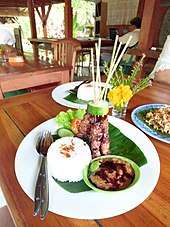
The skewers used for chicken satay are traditionally made from lidi, a midrib of coconut fronds. Bamboo skewers might be used instead. For firmer meats, such as lamb, goat, and beef, a thicker bamboo skewer is used. The skewers are usually soaked in water before using to avoid burning during grilling. Each skewer usually holds four pieces of meat, some only three pieces. A goat meat satay might insert a cube of fat between meat cubes. Turmeric is required to marinate satay to give the dish its characteristic yellow colour. Another popular marinade is sweet soy sauce mixed with coconut oil or palm margarine. The skewered meat is seasoned, marinated, and then grilled on charcoal embers.
Satay may be served with a spicy peanut sauce dip, or peanut gravy, served with slices of lontong or ketupat (rice cakes), garnished with a sprinkle of bawang goreng (crisp fried shallot), and accompanied by acar (pickles) consisting of slivers of onions, carrots, and cucumbers in vinegar, salt, and sugar solution. Mutton satay is usually served with kecap manis (sweet soy sauce) instead of peanut sauce. Pork satay can be served in a pineapple-based satay sauce or cucumber relish. An Indonesian version uses a soy sauce-based dip. Satays usually presented as it is, a bunch of skewered meats richly coated with peanut sauces. All these sauce come with a cold vegetable, which is called "acar timun." It's similar to pickles here and called, "ajad" in Thailand. Today, however, fine dinings and fancy restaurants tried to improve the food presentation aspect of satays to become more visually appealing.
Variants and outlets of note
Indonesia
Indonesia is the home of satay (known as sate in Indonesian and pronounced similar to the English "satay"), and satay is a widely renowned dish in almost all regions of Indonesia; it is considered the national dish and one of Indonesia's best dishes.[14] Satays, in particular, are a staple in Indonesian cuisine, served everywhere from street carts to fine dining establishments, as well as in homes and at public gatherings.[25] As a result, many variations have been developed throughout the Indonesian Archipelago.
In Indonesia there are some restaurants that specialised on serving various kinds of satay and present it as their speciality, such as Sate Ponorogo Restaurant, Sate Blora Restaurant, and also chains of Sate Khas Senayan restaurants, previously known as Satay House Senayan.[26] In Bandung, the West Java Governor's office is popularly called Gedung Sate (Indonesian: Satay building) to refer the satay-like pinnacle on its roof.
Indonesia has the richest variations of satay in the world. The satay variants in Indonesia usually named after the region its originated, the meats, parts or ingredients its uses, also might named after the process or method of cooking.[27]
Chicken
- Sate Ambal
- A satay variant from Ambal, Kebumen, Central Java. This satay uses a native breed of poultry, ayam kampung. The sauce is not based on peanuts, but rather ground tempe, chilli and spices. The chicken meat is marinated for about two hours to make the meat tastier. This satay is accompanied with ketupat.Sate ayam, chicken satay
- Sate Ayam
- Chicken satay, the most common and widely distributed type of satay in Indonesia.
- Sate Banjar
- A variant of chicken satay popular in South Kalimantan, especially in the town of Banjarmasin.
- Sate Blora
- A variant originating in Blora, in Central Java. This variant is made of chicken (meat and skin) pieces that are smaller compared to the other variants. It is normally eaten with peanut sauce, rice, and a traditional soup made of coconut milk and herbs. Sate Blora is grilled in front of buyers as they are eating. The buyers tell the vendor to stop grilling when they are sated.
- Sate Kulit
- Skin Satay. Found in Sumatra, this is a crisp satay made from marinated chicken skin.
- Sate Madura
- Originating on the island of Madura, near Java, it is a famous satay variant among Indonesians. Most often made from mutton or chicken, the recipe's main characteristic is the black sauce made from Indonesian sweet soy sauce/kecap manis mixed with palm sugar (called gula jawa or "Javanese sugar" in Indonesia), garlic, deep fried shallots, peanut paste, petis (a kind of shrimp paste), kemiri (candlenut), and salt. Chicken Madura satay is usually served in peanut sauce, while the mutton Madura satay is usually served in sweet soy sauce. Sate Madura uses thinner chunks of meat than other variants. It is eaten with rice or rice cakes wrapped in banana/coconut leaves (lontong/ketupat), they are usually sliced into smaller pieces before being served. Raw thinly sliced shallots and plain sambal are often served as condiments
- Sate Ponorogo
- A variant of satay originating in Ponorogo, a town in East Java. It is made from sliced marinated chicken meat, and served with a sauce made of peanuts and chilli sauce and garnished with shredded shallots, sambal (chili paste) and lime juice. The meat is marinated in spices and sweet soy sauce, in a process called bacem and is served with rice or lontong (rice cake). The grill is made from terracotta earthenware with a hole in one side to allow ventilation for the coals. After three months of use, the earthenware grill disintegrates, and must be replaced.
- Sate Taichan
- A spicy chicken satay in hot sambal sauce, served with lontong, popular in Jakarta. It was said that the dish was an adaptation of skewered Chinese snack from Taiwan, which originally uses pork or rabbit meat, and served with soy sauce. The Indonesian version maintain the light Chinese-style seasoning, replaces pork with chicken, and adds spiciness with the addition of hot sambal.[28] Another source mentioned that sate Taichan was devised from a Japanese man's specific request that his satay omits peanut sauce and sweet soy sauce, and only seasoned with a dash of salt and lime juice, and served with chili paste.[29]
Beef
- Sate Buntel
- Lit: Wrapped Satay, a speciality from Solo or Surakarta, Central Java.[30] It is made from minced beef or goat (especially meats around ribs and belly area). The minced fatty meats are wrapped by thin fat or muscle membrane and wrapped around a bamboo skewer. The size of this satay is quite large, very similar to a middle eastern kebab. After being grilled on charcoal, the meat is separated from the skewer, cut into bite-size chunks, then served in sweet soy sauce and merica (pepper).
- Sate Lembut
- A rare satay recipe of the Betawi people. It is can be found in Jalan Kebon Kacang, Central Jakarta. The satay is made from minced beef mixed with shredded coconut and spices, wrapped around a flat bamboo skewer. Usually eaten with ketupat laksa betawi (Betawi style Laksa with ketupat glutinous compressed rice).
- Sate Manis
- Also a speciality from the Betawi people. It is also can be found in Jalan Kebon Kacang, Central Jakarta. The satay is made from slices of has dalam (tenderloin) the finest part of beef, marinated with sweet spices. Usually eaten with ketupat laksa betawi.
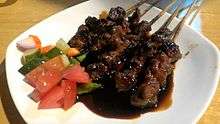
- Sate Maranggi
- Commonly found in Purwakarta and Cianjur, the cities in West Java, this satay is made from beef marinated in a special paste.[31] The two most important elements of the paste are kecombrang (Nicolaia speciosa) flower buds and ketan (sweet rice) flour. Nicola buds bring a unique aroma and a liquorice-like taste. The satay is served in sweet soy sauce with acar pickles. It is served with ketan cake (jadah) or plain rice.
- Sate Matang
- A satay variant from Matang Geulumpang Dua, Bireun, Aceh. This satay is made from beef, usually served with peanut sauce and soto or soup separately.
- Sate Sapi
- Beef satay, served in sweet soy sauce and peanut sauce. Specialty of Jepara town in Central Java.
- Sate Susu
- Literally it means "milky satay", however it contains no milk, the term susu is actually refer to cow's breast or udder. This tasty dish that can be found in Java and Bali, is made from grilled spicy beef udder, served with hot chilli sauce.[32]
Other red meats
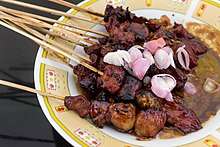
- Sate kambing
- Goat satay, a variant of satay popular in Java, made with goat, lamb or mutton meat. Different than other satays, sate kambing (lamb satay) is not usually pre-seasoned or pre-cooked. Raw lamb/goat is skewered and grilled directly on the charcoal. It is then served with sweet soy sauce, sliced shallots, and cut-up tomatoes. Since the meat is not pre-cooked, it is important to use young lamb. The best vendors use lamb under three to five months old. Lamb from goat is also more popular than lamb from sheep due to milder flavor.
- Sate Kerbau
- Water buffalo satay, a variant of satay popular in Kudus, where most Muslim believed that it is forbidden to eat beef to respect the Hindus. This satay is made with water buffalo meat. The meat is cooked first with palm sugar, coriander, cumin, and other seasoning until very tender. Some vendor choose to even grind the meat first to make it really tender. It is then grilled on charcoal, and served with sauce made with coconut milk, palm sugar, and other seasoning. Traditionally, satay kerbau is served on a plate covered with teak wood leaves.
- Sate Tegal
- A sate of a yearling or five-month-old lamb; the nickname for this dish in Tegal is balibul, an acronym of baru lima bulan (just five months). Each kodi, or dish, contains twenty skewers, and each skewer has four chunks — two pieces of meat, one piece of fat and then another piece of meat. It is grilled over wood charcoal until it is cooked between medium and well done; however it is possible to ask for medium rare. Sometimes the fat piece can be replaced with liver or heart or kidney. This is not marinated prior to grilling. On serving, it is accompanied by sweet soya sauce (medium sweetness, slightly thinned with boiled water), sliced fresh chilli, sliced raw shallots (eschalot), quartered green tomatoes, and steamed rice, and is sometimes garnished with fried shallots.
Pork

- Sate Babi
- Pork satay, popular among the Indonesian Chinese community, most of whom do not share the Muslim prohibition against pork. This dish can be found in Chinatowns in Indonesian cities, especially around Glodok, Pecenongan, and Senen in the Jakarta area. It is also popular in Bali where the majority are Hindus, it is also popular in North Sulawesi, the North Tapanuli, and Nias, where most people are Christians, and also popular in the Netherlands.
- Sate plecing
- Pork satay, popular in Balinese cuisine.
Fish and seafood
- Sate ikan tuhuk
- Blue marlin Satay, a delicacy from Krui, Lampung.[33]
- Sate Bandeng
- Milkfish Satay, from Banten. It is a satay made from boneless bandeng (milkfish). The seasoned spicy milkfish meat is separated from the small bones, then placed back into the milkfish skin, clipped by a bamboo stick, and grilled over charcoal.
- Sate Belut
- Eel Satay, another Lombok rare delicacy. It is made from belut, (lit. eel ) commonly found in watery rice paddies in Indonesia. A seasoned eel is skewered and wrapped around each skewer, then grilled over charcoal fire, so each skewer contains an individual small eel.
- Sate Kerang
- Shellfish satay. The most popular variant of sate kerang is from Medan, North Sumatra, it is rich spicy cooked shellfish in skewer an often become oleh-oleh (food gift) for visitors visiting Medan.[34] In Java sate kerang it is mildly marinated and boiled, also served as a side-dish to accompany soto.
- Sate Udang
- Shrimp Satay that uses large shrimps or prawns,[35] shelled and cleaned and often with the tails off and lightly grilled. Some recipes call for a marinade of thick coconut milk with sambal (chili paste), powdered laos (galangal root), ground kemiri (candlenut, one can substitute macadamia nuts in a pinch), minced shallots and pressed garlic. One can add salt to taste. Shrimp satay seldom served with the peanut sauce so popular with other satays, because it might overpower a delicate shrimp flavour.
Offals
- Sate Ampet
- Another Lombok delicacy. It is made from beef, cow's intestines and other cow's internal organs. The sauce for sate ampet is hot and spicy, which is no surprise since the island's name, lombok merah, means red chili. The sauce is santan (coconut milk) and spices.[36]
- Sate Babat
- Tripe satay. Mildly marinated and mostly boiled than grilled, usually served as a side-dish to accompany soto.
- Sate Burung Ayam-ayaman
- Bird Satay, the satay is made from gizzard, liver, and intestines of burung ayam-ayaman (watercock). After being seasoned with mild spices and stuck on a skewer, this bird's internal organs aren't grilled, but are deep fried in cooking oil instead.
- Sate Hati
- Liver Satay. There is two types of liver satays, cattle liver (goat or cow) and chicken liver satay. The cattle liver made by diced whole liver, while the chicken liver satay is made from mixture of chicken liver, gizzard, and intestines. Usually gizzard is placed on the bottom, intestine on the center and liver or heart on the top. After seasoning, the internal organs are not fried or grilled, but are boiled instead. It's not treated as a main dish, but often as a side dish to accompany bubur ayam (chicken rice porridge).
- Sate Kikil
- Cow skin satay from Java, this satay is made from boiled cow skin, skewered and seasoned either in spicy peanut sauce or yellow sauce.[37]
- Sate Makassar
- From a region in Southern Sulawesi, this satay is made from beef and cow offal marinated in sour carambola sauce. It has a unique sour and spicy taste. Unlike most satays, it is served without sauce.
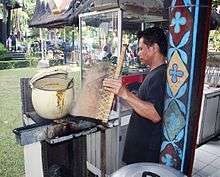
- Sate Padang
- A dish from Padang and the surrounding area in West Sumatra, which is made from cow or goat offal and meat boiled in spicy broth then grilled. Its main characteristic is a yellow sauce made from rice flour mixed with spicy offal broth, turmeric, ginger, garlic, coriander, galangal root, cumin, curry powder and salt.[38] It is further separated into two sub-variants, the Pariaman and the Padang Panjang, which differ in taste and the composition of their yellow sauces.
- Sate Torpedo
- Testicles satay. Satay made from goat testicles marinated in soy sauce and grilled. It is eaten with peanut sauce, pickles, and hot white rice.
- Sate Usus
- Chicken intestine satay. This mildly marinated satay is usually fried, also as a side-dish to accompany bubur ayam.
Mixture
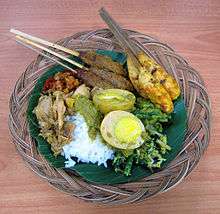
- Sate Lilit
- A satay variant from Balinese cuisine. This satay is made from minced beef, chicken, fish, pork, or even turtle meat, which is then mixed with grated coconut, thick coconut milk, lemon juice, shallots, and pepper. Wound around bamboo, sugar cane or lemon grass sticks, it is then grilled on charcoal.[39]
- Sate Pusut
- A delicacy from Lombok, the neighbouring island east of Bali. It is made from a mixture of minced meat (beef, chicken, or fish), shredded coconut meat, and spices. The mixture then is wrapped around a skewer and grilled over charcoal.
Eggs and vegetarian
- Sate Kere
- Lit: Poorman's satay. A cheap vegetarian satay made from grounded tempe from Solo city, served in peanut sauce and pickles. There two kinds of tempe: the most popular is made from soy bean, and the second is made from the side product material of tofu production (called Tempe Gembus). Sate Kere is usually made from Tempe Gembus. The word kere in the Javanese language means "poor"; it originally was meant to provide the poor people of Java with the taste of satay at an affordable price, since meat was considered a luxury. Although originally it was only vegetarian tempeh, today, sate kere also includes intestine, liver and beef satays mixed with tempeh ones. The materials are pre-cooked in baceman before grilled, then served with peanut sauce.
- Sate Telur Puyuh
- Quail eggs satay. Several hard-boiled quail eggs are put into skewers, marinated in sweet soy sauce with spices and boiled further, also served as a side-dish for soto.
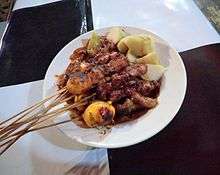
- Sate Telur Muda
- Young egg satay. This satay is made from premature chicken egg (uritan) obtained upon slaughtering the hens. The immature eggs that have not developed the eggshell yet are boiled and put onto skewers to be grilled as satay. The telur muda or uritan is often cooked on the same skewer as chicken skin satay, and mixed with chicken satay. This kind of satay is also usually served as side dish to accompany bubur ayam.
Others
- Sate Kelinci
- Rabbit meat Satay, this variant of satay is made from rabbit meat, a delicacy from Java. It is served with sliced fresh shallots (small red onion), peanut sauce, and sweet soy sauce. Rabbit satay usually can be found in mountainous tourist region in Java where locals breed rabbit for its meat, such as Lembang in West Java, Kaliurang in Yogyakarta, Bandungan and Tawangmangu resort in Central Java, also Telaga Sarangan in East Java.
- Sate Bulus
- Turtle satay, another rare delicacy from Yogyakarta. It is a satay made from freshwater bulus (softshell turtle). It is served with sliced fresh shallots (small red onion), pepper, and sweet soy sauce. Bulus meat is also served in soup or tongseng (Javanese style spicy-sweet soup).
- Sate Kuda
- Horse meat Satay. Locally known in Javanese as sate jaran, this is made from horse meat, a delicacy from Yogyakarta. It is served with sliced fresh shallots (small red onion), pepper, and sweet soy sauce.
- Sate Ular
- Snake Satay, a rare and exotic delicacy usually founds in foodstalls specialise on serving exotic reptile meats like snakes and biawak (monitor lizards), such as the one founds near Gubeng train station in Surabaya, or near Mangga Besar and Tebet train station in Jakarta. It usually uses ular sendok (cobra) or sanca (python) meat. It is served with sliced fresh shallots (small red onion), pickles, pepper, and sweet soy sauce.
- Sate Blora
- Sate Banjar
- Goat liver satay
- Sate Padang with yellow sauce
 Sate buntel, Solo, Central Java
Sate buntel, Solo, Central Java- Sate sapi, beef satay from Jepara
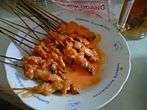 Sate srepeh from Rembang, Central Java
Sate srepeh from Rembang, Central Java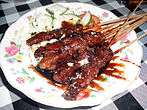 Horse satay, Yogyakarta
Horse satay, Yogyakarta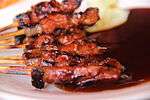 Balinese sate plecing, pork satay
Balinese sate plecing, pork satay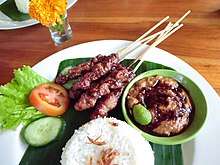 Balinese pork satay
Balinese pork satay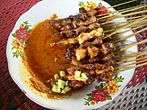 Sate Suranadi, Lombok
Sate Suranadi, Lombok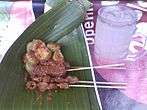 Sate kikil
Sate kikil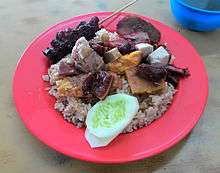 Indonesian Chinese nasi campur with pork satay
Indonesian Chinese nasi campur with pork satay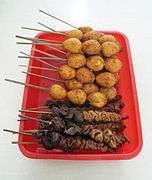 Eggs and intestine satays
Eggs and intestine satays- Soto with tripes and cockles satays
Malaysia
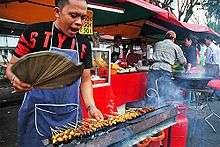
Known as sate in Malay[40] (and pronounced similarly to the English "satay"), it can be found throughout all the states of Malaysia in restaurants and on the street, with hawkers selling satay in food courts and Pasar malam. While the popular kinds of satay are usually beef and chicken satays, different regions of Malaysia have developed their own unique variations. Sate is often associated with Muslim Malays, but pork sate is also available at non-halal Chinese eating establishments.
There are a number of well-known satay outlets in Kajang, Selangor which is dubbed the Sate City in the country. Sate Kajang is a generic name for a style of sate where the meat chunks are bigger than normal, and the sweet peanut sauce served along with a portion of fried chilli paste. Given its popularity, sate Kajang is now found throughout Malaysia. Stalls and restaurants around Kajang offer not only the more traditional chicken or beef satay, but also more exotic meats such as venison, rabbit or fish, as well as gizzard, liver, and a number of other variations.
Another type of meat satay is the sate lok-lok from Penang and sate celup (dip satay) from Malacca. Both are Malaysian Chinese fusions of the hotpot and the Malay satay. Pieces of raw meat, tofu, century eggs, quail eggs, fish cake, offal or vegetables are skewered on bamboo sticks. These are cooked by being dipped in boiling water or stock. The satay is then eaten with a sweet, dark sauce, sometimes with chilli sauce as an accompaniment. If the satay is eaten with satay sauce, it is called sate lok-lok. If the satay is cooked with boiling satay peanut sauce, it is called sate celup. Both dishes are available from street vendors or in certain restaurants, and the majority are not halal. Customers use a common container containing boiling stock to personally cook their satay. Sauces are either served in common containers or individually. There are usually no tables near street vendors, and customers thus tend to gather around the food cart.
Netherlands

Known as saté or sateh, it is fully adapted in Dutch everyday cuisine. Owed to their shared colonial history, satay is an Indonesian food that has become an integral part of Dutch cuisine.[41] Pork and chicken satays are almost solely served with spicy peanut sauce and called een sateetje, and are readily available in snackbars and supermarkets.[42] Versions with goat-meat (sateh kambing) and sweet soy sauce are available in Indonesian restaurants and take-aways. Pork or chicken satay in peanut sauce, with salad and French-fries, is popular in pubs or eetcafes. With Indonesian take-away meals like nasi goreng speciaal, the special part is often a couple of sate-sticks. Another favourite in Dutch snackbars is the satékroket, a croquette made with a peanut sauce and shredded meat ragout.
Philippines
In the majority of the Philippines, satay (especially pork or chicken) is referred to as inihaw or inasal, or by the generic English name "barbecue" (usually shortened to "BBQ").[43][44][45] It is usually served glazed in a sweet-soy sauce marinade reminiscent of yakitori, highlighting Japanese and East Asian influence in the archipelago. Despite the native origins of inasal and inihaw, the English association of Barbeque is the source of the portmanteau names for other popular street foods that are also served skewered, such as banana cue ("banana" + "barbecue") and camote cue ("camote (sweet potato) + barbecue").[46]
Satay is known as satti in the Southern Philippines (especially in the regions of Zamboanga, Sulu Archipelago and Tawi-Tawi).[47] Satti is usually made from chicken or beef among Muslim Filipinos.[44] It is particularly popular in Tausug cuisine and is commonly eaten as breakfast in restaurants which specialise in satti. It is typically served with ta'mu (pusô in other Philippine languages) and a bowlful of warm sauce.[48]
Offal-based versions of satay are also commonly sold in the Philippines as street food. The most popular are made from chicken or pork intestines known as isaw. Other variants use liver, tripe, lungs, chicken heads and feet, cubes of coagulated pork blood, and pork ears, among others.[49][50]
Annatto seeds and banana ketchup-based sauces are also widely used which gives the meat a vibrant orange or red colour.[48][51]
Singapore
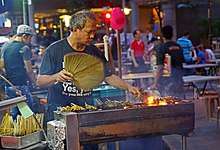
In Singapore, satay is sold by Chinese, Malay and Indian Muslim vendors. It is thought to have originated in Java and brought to Singapore by Muslim traders.[52] Satay is one of the earliest foods to be associated with Singapore; it has been associated with the city since the 1940s. Previously sold on makeshift roadside stalls and pushcarts, concerns over public health and the rapid development of the city led to a major consolidation of satay stalls at Beach Road in the 1950s, which came to be collectively called the Satay Club. They were moved to the Esplanade Park in the 1960s, where they grew to the point of being constantly listed in tourism guides. Open only after dark with an open air or "al fresco" dining concept, the Satay Club defined how satay is served in Singapore since then, although they are also found across the island in most hawker stalls, modern food courts, and upscale restaurants at any time of the day. Moved several times around Esplanade Park due to development and land reclamation, the outlets finally left the area permanently to Clarke Quay in the late 1990s to make way for the building of the Esplanade - Theatres on the Bay.
Several competing satay hotspots have since emerged, with no one being able to lay claim to the reputation the Satay Club had at the Esplanade. While the name has been transferred to the Clarke Quay site, several stalls from the original Satay club have moved to Sembawang in the north of the city. The satay stalls which opened at Lau Pa Sat are popular with tourists. Served only at night when Boon Tat Street is closed to vehicular traffic and the stalls and tables occupy the street, it mimics the open-air dining style of previous establishments. Other notable outlets include the ones at Newton Food Centre, East Coast Park Seafood Centre and Toa Payoh Central.
Peanut sauce is used in Singaporean satays, Malay satay is quite similar to Indonesian satay by using kecap manis (sweet soy sauce), while Chinese Hainan satay uses pineapple purée sauce and marinated in five-spice powder.[52] The common types of satay sold in Singapore include Satay Ayam (chicken satay), Satay Lembu (beef satay), Satay Kambing (mutton satay), Satay Perut (beef intestine), and Satay Babat (beef tripe).
Singapore's national carrier, Singapore Airlines, also serves satay to its First and Business Class(previously known as raffles class) passengers as an appetiser.
Sri Lanka
Sathe as it is known in Sri Lanka is a Sri Lankan Malay dish that has become a staple of the country's diet.[16] Sathe is served with peanut and chili sauce.[16] It is sometimes called sate daging by the country's Malay community.[53]
Thailand
Satay (Thai: สะเต๊ะ, RTGS: sate, pronounced [sā.téʔ̚]) is a popular dish in Thailand.[54] Usually served with peanut sauce and achat, Thai satay have various recipes, from chicken, beef, and pork, to vegetarian variants that employ soy protein strips or tofu. Satay can easily be found in virtually any Thai restaurant worldwide. Satay came to Thailand via Indonesia.[23] Because Thai cuisine is heavily marketed internationally and has attracted world culinary attention earlier than Indonesian cuisine, despite its Indonesian origin, there is a widespread misconception abroad that satay originated from Thailand. As a result, it is most frequently associated with Thai food.[55] For example, in the United States, satay is said to be one of America's favourite Thai dishes.[56]
There is a lot of satay in Thailand. For example, we can found it in Southern Thailand. It has a satay called "hoi malaeng puu" made with mussels in the top and satay udang (ginger paste and shrimp). It's also popular in Singapore. Nonetheless, as Thai satay has evolved through the use of different marinades, sauces, and meats from the original version of the dish, it can be argued that the Thai and Indonesian satays are two different dishes that only share the same name and origin. Due to the global popularity of Thai cuisine and the lower numbers of Indonesian restaurants outside of Indonesia, diners outside the region, particularly those in the West, are more likely to be referring to the Thai version rather than the original Indonesian version when referencing the dish. A Thai popular street food, khao niao mu ping, grilled pork on a skewer, is believed to be influenced by satay.
The first satay restaurant in Thailand was in front of Chaloem Buri Theater near the Chaloem Buri Intersection in the Yaowarat neighborhood. Now it is on Rama IV Road near Lumphini MRT station and has been for more than 50 years.[58]
Fusion satay

A popular misconception is that the term "satay" is a peanut sauce. Traditionally, satay referred to any grilled skewered meats with various sauces; it is not necessarily served solely with peanut sauce. However, since the most popular variant of satay is chicken satay in peanut sauce (Sate Madura in Indonesia, Sate Kajang in Malaysia, and Thai chicken satay with peanut sauce), in modern fusion cuisine the term "satay" has shifted to satay style peanut sauce instead.[9]
For example, the fusion "satay burger" refers to beef hamburger served with so-called "satay sauce", which is mainly a kind of sweet and spicy peanut sauce or often replaced with gloppy peanut butter.[59][60] The Singapore satay bee hoon is actually rice vermicelli served in peanut sauce. The American-Thai fusion fish fillet in satay sauce also demonstrates the same trend. The fusion French cuisine Cuisses de Grenouilles Poelees au Satay, Chou-fleur Croquant is actually frog legs in peanut sauce.[61] The Indomie instant noodle is also available in satay flavour, which is only the addition of peanut sauce in its packet.[62][63] In Hong Kong, satay sauce is usually served with instant noodles and stir-fried beef. This dish is most often eaten for breakfast.[64]
See also
- Brochette
- Satay building
- List of chicken dishes – Wikipedia list article
- Pinchitos – Southern Spain skewered meat dish
- Shacha sauce, also known as Sate-sauce
- Yakitori

References
- Sara Schonhardt (25 February 2016). "40 Indonesian foods we can't live without". CNN.
- Bruce Kraig; Colleen Taylor Sen (2013). Street Food Around the World: An Encyclopedia of Food and Culture. ABC-CLIO. p. 183. ISBN 9781598849554.
- O'Neill, Molly (2 July 2000). "Food; The Stick Shift". The New York Times. ISSN 0362-4331. Retrieved 13 April 2020.
- "Grilled Beef Satay". Food Reference.com. Retrieved 6 July 2010.
- Alan, Davidson (2006). The Oxford Companion to Food (2nd ed.). Oxford: OUP. ISBN 9780191018251. OCLC 862049879.
- admin (11 December 2013). "What is Satay Food and Its Origin". Satay Ria. Retrieved 7 June 2020.
- Marx, Pamela (1996). The Travel-the-world Cookbook. Good Year Books. p. 30. ISBN 9780673362544.
indonesian satay peanut sauce.
- "Peanut butter and satay sauce – recipe". The Guardian.
- "Consumers love succulent Satay, Peanut ingredients for global success" (PDF). USA Peanuts. p. 1. Archived from the original (PDF) on 2 May 2014. Retrieved 2 May 2014.
- Felicity Cloake (30 January 2014). "How to cook the perfect chicken satay". The Guardian. Retrieved 7 July 2014.
- "Satay Washington DC". satay.com. Retrieved 6 July 2014.
- Media, Kompas Cyber. "Kemenpar Tetapkan 5 Makanan Nasional Indonesia, Ini Daftarnya". KOMPAS.com (in Indonesian). Retrieved 18 April 2018.
- Owen, Sri (1999). Indonesian Regional Food and Cookery. ISBN 9780711212732. Retrieved 7 July 2010.
- Sara Schonhardt and Melanie Wood (15 August 2011). "40 of Indonesia's best dishes". CNN. Retrieved 6 July 2014.
- "So much more to satay than peanut sauce". Food. Retrieved 21 August 2018.
- Bullis, Douglas; Hutton, Wendy (2001). Food of Sri Lanka. Periplus. p. 14.
- CNN Go Archived 11 November 2012 at the Wayback Machine Your pick: World's 50 most delicious foods, 7 September 2011. Retrieved 11 October 2011
- Alan, Davidson (2006). The Oxford Companion to Food (2nd ed.). Oxford: OUP. ISBN 9780191018251. OCLC 862049879.
- "satay, n." Oxford English Dictionary.
- Satay, The Free Dictionary
- Bruce Kraig; Colleen Taylor Sen (2013). Street Food Around the World: An Encyclopedia of Food and Culture. ABC-CLIO. p. 183. ISBN 9781598849554.
- Christina Andhika Setyanti (30 August 2016). "Sepotong Sejarah Autentik Indonesia dalam Semangkuk Tongseng" (in Indonesian). CNN.
- David Joachim; Andrew Schloss (2010). Mastering the Grill: The Owner's Manual for Outdoor Cooking. Chronicle Books. p. 116. ISBN 9780811878357.
- Engelbrecht, Karin. "A Look at Culinary Influences on the Dutch Kitchen – How Other Cuisines Influenced the Dutch Kitchen Throughout History". About Food.
- "Satay Junction, Indonesian Cuisine". Satay Junction. Retrieved 6 July 2010.
- Media, Kompas Cyber (14 February 2009). "Sate Khas Senayan Tidak Sekadar Jualan Sate".
- "Sataysfying Sataysfaction". My Cooking Without Borders. 19 May 2011. Retrieved 15 January 2015.
- "Introducing 'sate taichan,' Jakarta's popular spicy satay dish". The Jakarta Post. 26 December 2016.
- "How a Japanese man gave Indonesian satay a twist". The Jakarta Post. 17 February 2017.
- "Sate buntel, makanan kesukaan Jokowi" (in Indonesian). BBC Indonesia. 20 October 2014. Retrieved 22 October 2017.
- "Sate Maranggi – Purwakarta Beef Satay – Daily Cooking Quest". Daily Cooking Quest. 5 October 2015. Retrieved 22 October 2017.
- "Sate Susu ala Bali". KOMPAS.com (in Indonesian). Archived from the original on 29 June 2016. Retrieved 22 October 2017.
- Media, Kompas Cyber. "Promosi Lewat Ikan Tuhuk". KOMPAS.com (in Indonesian). Retrieved 26 April 2018.
- "Sate Kerang Istimewa Rahmat". Medan Magazine (in Indonesian). 27 March 2012. Archived from the original on 29 March 2012. Retrieved 22 June 2012.
- Food to Love. "Satay prawns". Women's Weekly Magazine. Retrieved 15 June 2016.
- "Sate Ampet/Sate Bulayak Lombok" (in Indonesian). Retrieved 13 January 2018.
- "30 resep sate kikil enak dan sederhana". Cookpad (in Indonesian). Retrieved 13 January 2018.
- Post, The Jakarta. "Where to find a mouth-watering 'sate Padang' dinner in South Jakarta". The Jakarta Post. Retrieved 13 January 2018.
- Kitchen, Esensi's. THE SATAY. Esensi.
- Munan, H. (2008). CultureShock! Malaysia: A Survival Guide to Customs and Etiquette. Culture shock!. Marshall Cavendish International (Asia) Ptd Limited. p. 154. ISBN 978-981-4408-95-0. Retrieved 10 May 2017.
- "Top 10 Dutch foods – with recipes". Retrieved 7 November 2017.
- Frommer's Irreverent Guide to Amsterdam, 2004, p 66
- Ellen Brown (14 June 2016). "Smart Cooking: Philippine cuisine shaped by many influences". Providence Journal. Retrieved 8 February 2017.
- Jimenez, Gidget (2015). All About the Philippines: Stories, Songs, Crafts and Games for Kids. Tuttle Publishing. p. 59. ISBN 9781462917259. Retrieved 5 September 2016.
- Raichlen, Steven. "Filipino Satti". Barbeuce! Bible. Retrieved 5 September 2016.
- Overseas Pinoy Cooking.Net website. Retrieved 6 November 2010
- "Travel Gastronomy: Satti Ala Zambo ~ Boarding Gate 101". Retrieved 15 January 2015.
- "Unique Flavors of Western Mindanao: Satti". Retrieved 15 January 2015.
- "Isaw ng Manok (Grilled Chicken Intestine)". Panlasang Pinoy. Retrieved 6 September 2016.
- "Isaw and other Pinoy Street Barbecue". Ang Sarap. Retrieved 6 September 2016.
- Edgar Soon (2009). Pairing Wine with Asian Food. Monsoon Books. ISBN 9789814358941.
- Polytechnic, Temasek (15 July 2015). Singapore Hawker Classics Unveiled: Decoding 25 Favourite Dishes. Marshall Cavendish International Asia Pte Ltd. ISBN 9789814677868.
- Sri Lankan Malay Recipes. Galadari Hotel Colombo. p. 9. ISBN 955-8529-001.
- "Satay.com - Cooking Recipes of Thai Food and Asian Cuisine – Thai Satay Recipes Cookbook". Retrieved 15 January 2015.
- "What Is Satay?". wiseGEEK. Retrieved 15 January 2015.
- Aggarwal, Uma (2013). America's Favorite Recipes, Part II. iUniverse. ISBN 9781475977851.
- "The World of Satay". Saveur. Retrieved 7 June 2020.
- ทุมนานนท์, ดร.ธนา (29 April 2013). "หมูสะเต๊ะ เจ้าแรกของประเทศไทย (เจริญพร)". Thai Rath (in Thai). Retrieved 5 April 2018.
- "Peanut Satay Burgers". cheese-burger.net.
- NewsLifeMedia. "Satay Chicken Burgers Recipe". Retrieved 15 January 2015.
- "Cuisses de Grenouilles Poelees au Satay, Chou-fleur Croquant". Archived from the original on 7 January 2010.
- "Indomie, Seleraku! :: Page Not Found". indomie.com.
- "Loading..." indonesianfoodmart.com.
- Chee-Beng, Tan (1 August 2012). Chinese Food and Foodways in Southeast Asia and Beyond. NUS Press. ISBN 9789971695484.
External links
| Wikimedia Commons has media related to Satay. |
| Look up satay in Wiktionary, the free dictionary. |
- Recording of an Indonesian sate seller in Jakarta
- Indonesian chicken satay recipe
- Indonesian pork satay recipe
- Surabaya coconut beef satay recipe
- Balinese chicken satay recipe
- Malaysian chicken satay recipe
- Singapore chicken satay recipe
- Zamboanga: Satti in the city and more
- Travel Gastronomy: Satti Ala Zambo
- Thai chicken satay recipe
